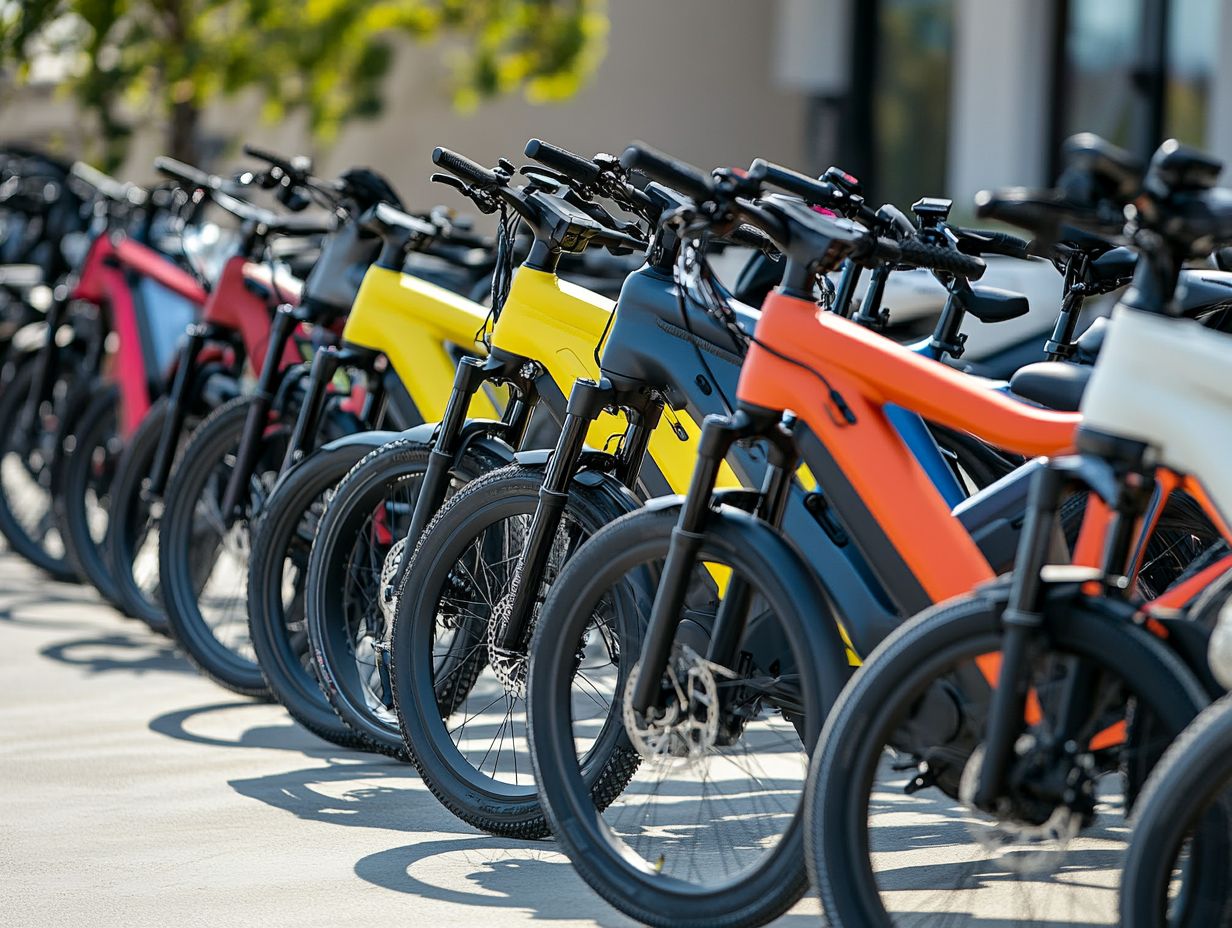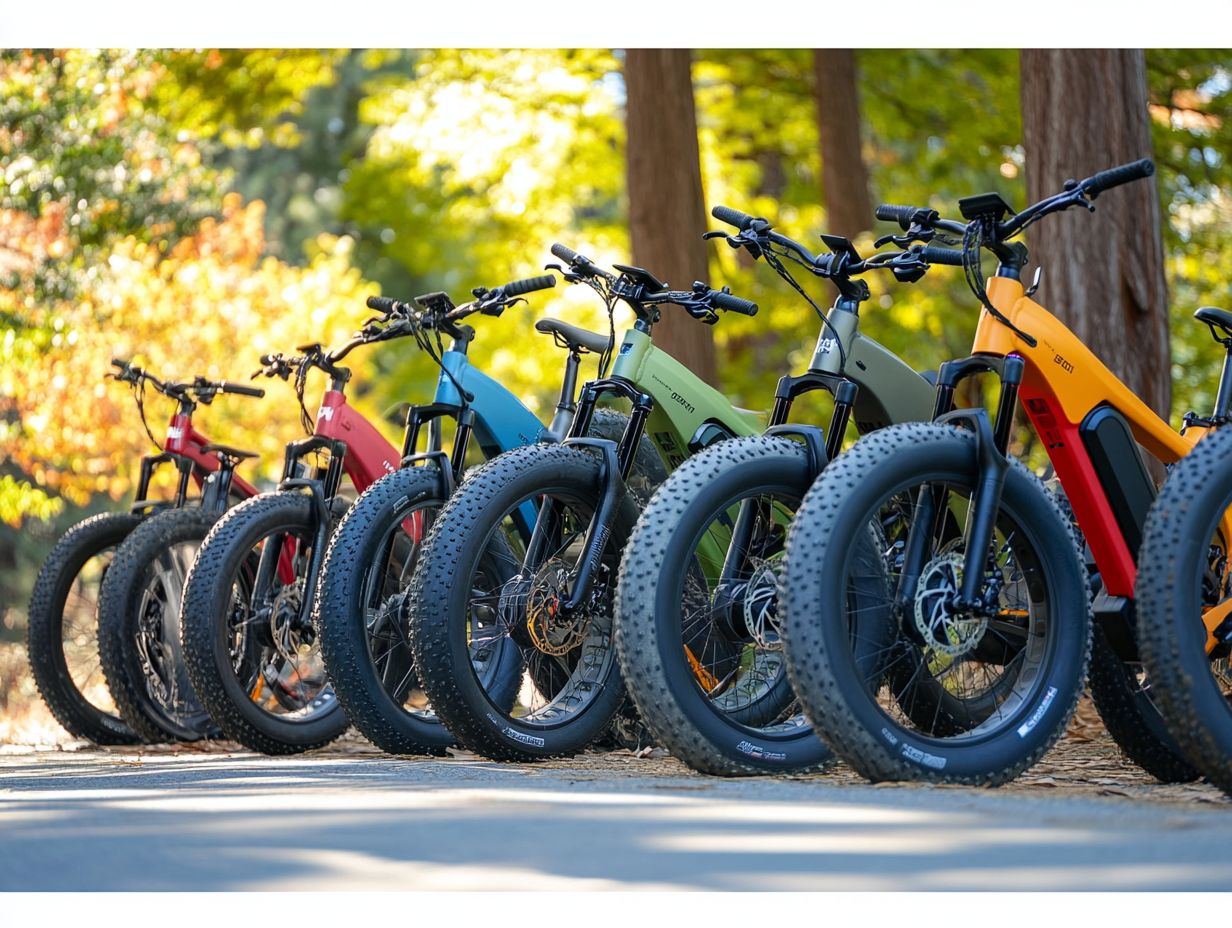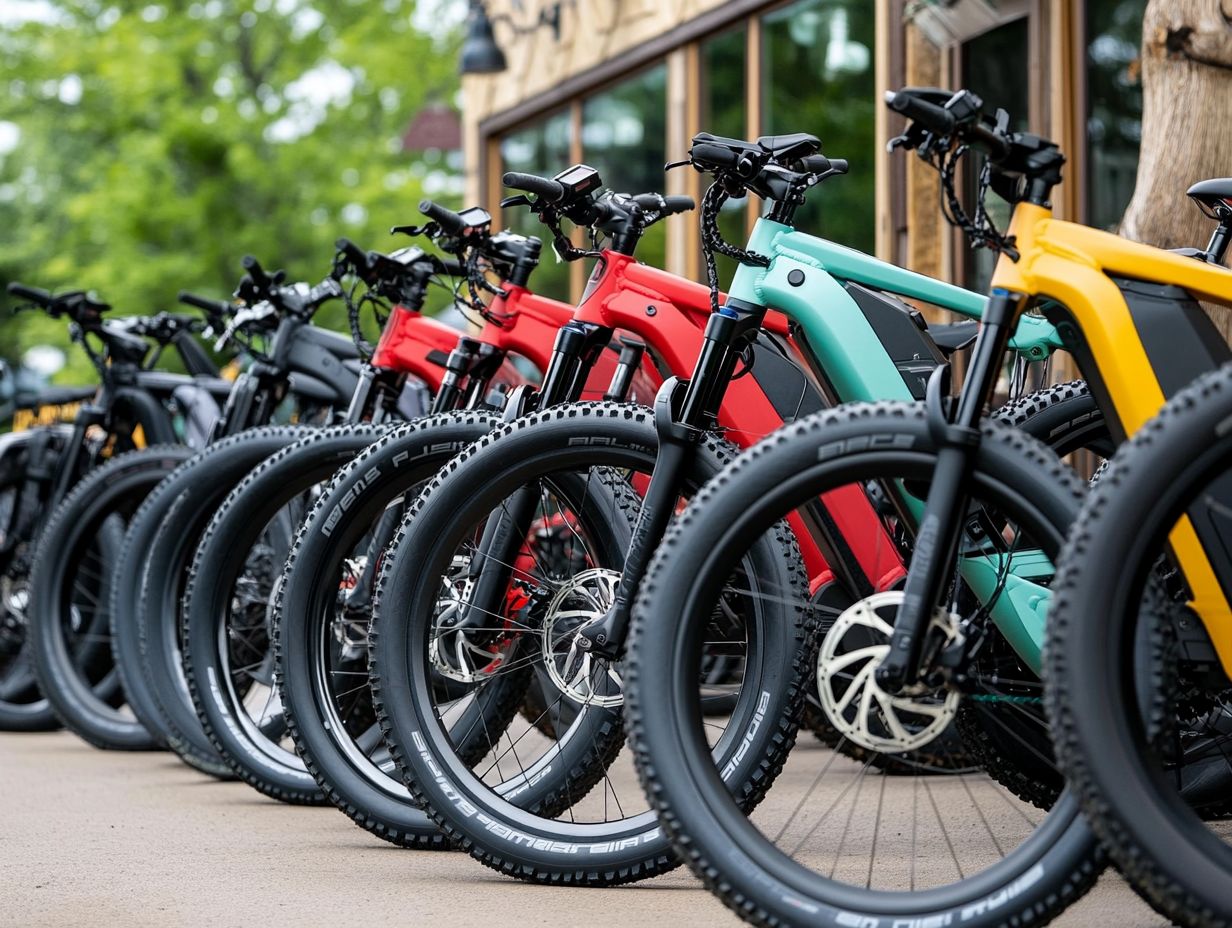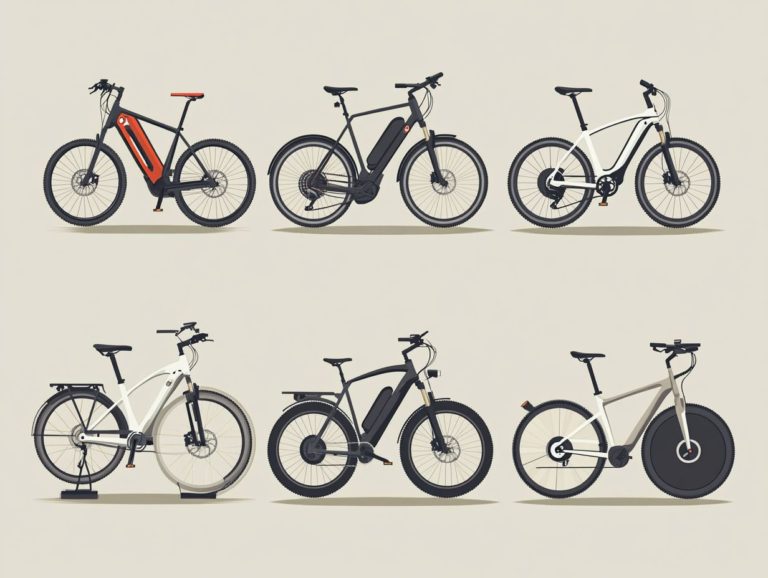Comparing Different Electric Bicycle Designs
Electric bicycles are revolutionizing the way you commute, seamlessly combining convenience with eco-friendliness.
With an array of classifications and features, along with design considerations that boost performance, there s a wealth of information waiting for you to explore. This guide explores the different types of electric bikes. It highlights key features like battery placement and frame materials.
It also offers a comparative analysis of designs to help you identify the perfect match for your needs and budget. Get ready for an exciting journey into the world of electric bicycles! You won’t believe how much easier commuting can be!
Contents
- Key Takeaways:
- Types of Electric Bicycles
- Design Considerations for Electric Bicycles
- Comparing Different Electric Bicycle Designs
- Factors to Consider when Choosing an Electric Bicycle
- Frequently Asked Questions
- What are the main factors to consider when comparing different electric bicycle designs?
- How can I determine the battery life of an electric bicycle?
- Which is better: a front-wheel or rear-wheel motor for an electric bicycle?
- What type of frame design is ideal for an electric bicycle?
- Are there any extra costs associated with owning an electric bicycle?
- Can I use an electric bicycle in the rain?
Key Takeaways:

- Electric bicycles come in various types, including pedal-assist, throttle-assist, and speed pedelec, each with unique features and functions.
- When comparing electric bicycles, consider design aspects such as battery placement, motor position, frame material, and suspension for optimal performance and comfort.
- Before choosing an electric bicycle, assess your personal needs and preferences, as well as budget and maintenance costs, to find the best fit for your lifestyle and budget.
What are Electric Bicycles?
Electric bicycles, or e-bikes, change how you commute and ride for fun. These modern bikes combine regular biking with help from an electric motor, offering you a more versatile and accessible riding experience.
The use of technology makes e-bikes especially attractive in city areas, where traffic congestion and pollution weigh heavily on many minds. E-bikes come with adjustable pedal assist levels and various battery options designed for different distances, enabling you to travel further and faster without breaking a sweat.
You can choose from multiple categories, such as:
- City commuters
- Mountain e-bikes engineered for rugged terrains
- Compact models perfect for easy storage
Each category is crafted to deliver a distinct riding experience. Their increasing popularity can be linked to their power to lessen reliance on cars, thereby fostering a healthier lifestyle and contributing to environmental sustainability.
Types of Electric Bicycles
The landscape of electric bicycles is expansive and diverse, featuring a range of e-bike categories tailored to various riding styles and purposes. From cargo bikes expertly designed for transporting goods to versatile models perfect for mountain biking, each category presents unique features and capabilities that cater to specific needs.
Grasping these distinctions is crucial for you as a potential buyer, particularly when navigating the best electric options available in the market.
Classifications and Features
Electric bicycles are categorized in various ways based on their design, functionality, and intended use, all of which significantly impact their performance and battery range. Features such as battery placement, integrated lights, and advanced technology like torque sensors are crucial in defining an e-bike’s efficiency and overall rider experience.
By understanding these classifications, you can navigate through e-bike reviews more easily and make informed choices when shopping for your next bike.
For instance, city e-bikes typically showcase mid-mounted motors that ensure balanced weight distribution, making them perfect for your urban commuting needs. On the other hand, mountain e-bikes often have robust batteries positioned on the downtube, providing better clearance and stability for those rugged adventures.
Accessories like panniers for cargo storage or GPS displays can significantly elevate your riding experience, enhancing both convenience and safety.
By recognizing these key distinctions, you can select an electric bicycle that seamlessly aligns with your lifestyle and riding preferences.
Design Considerations for Electric Bicycles

When you re choosing an electric bicycle, several key design considerations come into play that can greatly impact both performance and your overall comfort as a rider.
The strategic placement of batteries and the motor s position within the frame are vital elements that contribute to the bike’s balance and ride quality.
The choice of frame material and the type of suspension system you select are crucial factors affecting durability and smoothness. These elements are essential to consider, whether you re a senior looking for ease or an adventurous mountain biker seeking thrill.
Battery Placement and Motor Position
The placement of the battery and the position of the motor are crucial elements that directly impact your electric bike’s performance and battery life. A well-designed e-bike ensures that these components are strategically situated to make the bike work better for you, greatly enhancing your overall riding experience.
Innovations such as torque sensors enhance these configurations, providing smooth acceleration and intuitive control. For those interested in choosing the right model, exploring a guide to electric bicycle frame styles can turn modern electric bicycles into an absolute pleasure to ride.
By positioning the battery low and at the center, you ll improve stability and handling. A properly aligned motor allows for better weight distribution. When these elements work in harmony, your e-bike can tackle varied terrains effortlessly, maximizing power output and minimizing energy drain.
Thoughtful placement not only reduces the risk of damage from impacts and environmental factors but also extends the battery’s lifespan.
Many riders find that when their bike components are designed for optimal synergy, their satisfaction and confidence soar, leading to a more enjoyable and reliable journey.
Frame Material and Suspension
The choice of frame material and suspension system is crucial in defining the performance and comfort of your electric bicycle. Each option brings its own perks that elevate your riding experience, with lightweight materials like aluminum or carbon fiber often leading the charge due to the balance of strength and lightness.
If you re after a smoother ride especially over those bumpy paths incorporating advanced suspension technologies can significantly cushion those jolts and vibrations. Explore a range of options, from budget-friendly models to high-end variants packed with features.
The ideal combination of frame and suspension doesn t just affect how effortlessly you navigate urban landscapes; it also enhances your control during off-road escapades. This thoughtful selection allows for a cycling experience that s more enjoyable and tailored to your unique preferences.
Comparing Different Electric Bicycle Designs
By comparing various electric bicycle designs, you uncover valuable insights into the range of features and functionalities that directly influence bike performance and your riding experience.
Every design has its advantages and limitations, influenced by geometry, weight distribution, and technology integration. Engaging in ride testing becomes essential as you evaluate these differences, giving you the power to discover the electric models that perfectly align with your personal preferences and riding style. Additionally, choosing the right electric bicycle type for you can enhance your overall experience.
Design Features and Performance

Key design features greatly influence the performance of electric bicycles. Important aspects include integrated lights, battery range, and weight distribution.
When you choose an electric bike equipped with advanced technology, you re not just investing in a mode of transport; you re enhancing your overall riding experience. Whether you re commuting daily or heading out on a mountain biking adventure, understanding these design features is crucial.
Integrated lights do more than just illuminate your path during night rides; they significantly enhance your safety, making them essential for urban commuting.
Battery range is another major consideration. You ll want to know how far you can go on a single charge, with some models boasting impressive ranges that exceed 100 miles.
Weight distribution is vital for stability and maneuverability, particularly when navigating uneven terrain.
By carefully examining these features, you can make informed decisions that align perfectly with your unique riding needs and preferences.
Factors to Consider when Choosing an Electric Bicycle
Choosing an electric bicycle is exciting! Consider important factors to find the perfect fit for your lifestyle and needs. Your personal preferences whether you re leaning toward commuting or recreational use will significantly guide your options.
Budget limitations and expected maintenance costs are important factors in your decision. Evaluating these elements carefully will empower you to make a well-informed purchase that truly aligns with your requirements.
Personal Needs and Preferences
Identifying your personal needs and preferences is essential when selecting an electric bicycle. This ensures that the model you choose perfectly aligns with your lifestyle and intended use.
Whether you’re a senior rider in search of a convenient commuting solution or an outdoor enthusiast eager for a robust mountain bike, understanding your priorities will enable you to make an informed decision.
Your daily commuting distance, the type of terrain you regularly encounter, and your desired speed are pivotal in this selection process.
If you’re navigating an urban environment, lightweight options equipped with fenders and lights can significantly enhance your safety and convenience. On the other hand, if you often tackle hilly or rugged landscapes, you might gravitate toward more robust models that offer higher power and reinforced frames for added durability. To make an informed choice, consider understanding the anatomy of electric bicycles to find the best fit for your needs.
Additionally, personal factors such as storage capacity for groceries or workout gear can sway your choices. Consider exploring the 5 key differences between e-bike types to understand how these features can elevate your lifestyle, leading you to the perfect electric bicycle.
Budget and Maintenance Costs
Budget considerations are pivotal when deciding on an electric bicycle, as they directly influence the quality and features you can expect. It s vital to grasp the long-term maintenance costs to ensure your investment remains practical over time.
While there are many affordable models out there, you must strike a balance between cost, performance, and reliability during your shopping journey.
As you navigate the electric bicycle market, keep in mind both the initial purchase price and the anticipated upkeep expenses, which can vary widely among different brands and models.
Choosing a budget-friendly option doesn t mean you have to compromise on features like battery life, motor power, or warranty coverage. Dive into a world of options and discover the perfect electric bicycle for you!
By exploring various options and considering elements such as the manufacturer’s reputation and user reviews, you can uncover models that offer exceptional value without putting undue strain on your finances. For those new to the market, understanding different types of electric bicycles is crucial. Ultimately, the right electric bicycle will elevate your daily commutes and recreational outings, all while ensuring lasting durability and performance.
Frequently Asked Questions

What are the main factors to consider when comparing different electric bicycle designs?
Key factors include battery life, motor power, weight, and overall cost. Each feature impacts your riding experience directly.
How can I determine the battery life of an electric bicycle?
Check the battery’s power rating and voltage. A higher power rating usually means longer battery life!
Which is better: a front-wheel or rear-wheel motor for an electric bicycle?
This choice depends on your riding style. Front-wheel motors can offer stability, while rear-wheel motors provide better traction.
What type of frame design is ideal for an electric bicycle?
An ideal frame is lightweight and sturdy. It should also balance weight well for optimal performance.
Are there any extra costs associated with owning an electric bicycle?
Beyond the purchase price, consider costs for battery replacements and maintenance. Factor these into your budget for a clearer picture!
Can I use an electric bicycle in the rain?
Some bikes are weather-resistant, but riding in heavy rain can damage the electrical parts. Always check the manufacturer’s guidelines for safety.






